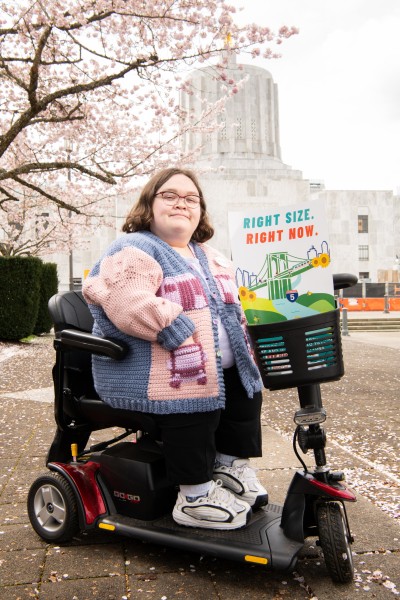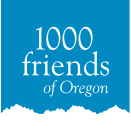By Krystal Eldridge and Cassie Wilson | 8.5-minute read

Q: You graduated as part of our 2021 LULI cohort. Since that training, how has your understanding of or interest in land use in Oregon grown or changed? Has it affected the work you’re doing now as a Gerhardt intern?
A: Before LULI, I knew nothing about land use or our state’s unique planning system, which shapes so much of what I love about Oregon. Hearing a presentation about age-friendly communities during LULI started connecting the dots between my interests in climate and disability justice, and land use, and introduced a new interest in transportation justice. I’ve spent the past couple of years growing this knowledge and interest and seeing how it plays out in the world around me.
As climate disasters increase in frequency and inequities persist, the way we plan our communities is critical. Different modes of transportation take up varying amounts of land, which affects where people live, work, study, and connect. Transportation can increase people’s quality of life by making it more efficient, affordable, and safe to get around. It can also make things harder through increased costs of living, exposure to air and noise pollution, traffic violence, poor access to opportunities, and by putting pressure on urban growth boundaries, which then threatens our farmland and forests. It’s important to recognize how the transportation projects and funding we prioritize are very much linked to land use.
Q: In your own words, what are you doing this summer as our Gerhardt intern, and what does the project you're working on mean to you? How has land use impacted your life?
A: I’m leading a research project on the development of House Bill 2017, Oregon’s last big transportation package, and its impacts with the goal of making recommendations to lawmakers on focus areas for the next state transportation package anticipated for the 2025 legislative session.
As someone who got involved in this work a few years after the passage of HB 2017, it’s been insightful to learn about the contents of the bill and how it all came together. It’s really easy to assume things have always been a certain way until you learn otherwise. This project has made me realize just how much HB 2017 included, such as funding for public transportation and Safe Routes To School. It’s been a pretty transformative experience for me on a personal level. It has deepened my interest in public policy, and research, and makes me excited to do more work like this after I graduate in 2024.
I live in Boring just outside of the Portland metro area’s urban growth boundary, and I see the impacts of our land use planning system everywhere I go. The suburbs come to a distinct halt at the edge of the urban growth boundary. We’ve got a local pumpkin patch and many nurseries just down the road, yet we’re only a short drive from town. I feel incredibly lucky to have grown up here, though there is still a lot of work to be done on meeting people’s basic needs.
Q: Your project is looking at Oregon’s 2017 transportation package to learn how it was crafted, and what its impact is. Is there anything specific that draws you to transportation as your core focus?
A: As a young person, I’m extremely concerned about the climate crisis and the impacts it’s already having on my community. Learning that transportation accounts for 40 percent of Oregon’s reported greenhouse gas emissions really motivated me to look at the intersection between climate and transportation. Learning about age-friendly communities made me think about my own experiences with the inaccessibility of our transportation system, and made me realize that I have a lot of thoughts and feelings about it.
When I was of legal age to learn to drive, I had no interest in learning. I had a lot of anxiety about the personal responsibility of driving and the potential to cause harm or be harmed by traffic violence. Eventually, I realized if I didn’t learn to drive there was really no way I’d be able to get a job, go to college, or move out because we don’t have access to public transportation. I watched my brother be let go from jobs because he didn’t have “reliable” transportation, because my mom would give him rides before he had a car. How is someone supposed to afford a car, insurance, gas, etc. without first having a job?
I’m disabled and I was reliant on Supplemental Security Income when I was learning to drive. With an income of less than $600 per month, transportation was my largest expense. I had to buy pedal extensions (several hundred dollars) and a stool with a tall handle I could pull up into the car with me because I’m only three foot seven. I had to buy a wheelchair lift for our van (several thousand dollars) which then also increased the cost of my car insurance. I was fortunate to not have to buy a vehicle because my mom voluntarily stopped driving hers due to disability, but that also led to me realizing the impacts of our transportation system on caregivers.
All of this to say, our transportation system is not designed well for people who can’t or don’t drive. Whether you’re younger or older, disabled, low-income, or otherwise choose not to drive, if you don’t live somewhere with public or active transportation infrastructure, then you’re dependent on friends and family who do drive or otherwise may not have your basic needs met.
In attending classes at Portland State, I drive to Gresham and ride TriMet’s FX2 bus to campus. That experience has shown me that public transportation is freedom. Even though I can and do drive now, it’s exhausting – getting in and out of the car with my stool, loading and unloading my mobility scooter, and driving itself all take precious energy out of me. I spend more time at local businesses, parks, the library, etc. when I can just easily get on and off a bus or the MAX without any extra energy required. Not driving to Portland also saves me a lot of stress because I can read a book or do homework on my ride.
Q: What do you see as the most pressing transportation policy issues facing Oregon, especially effective and equitable implementation of Land Use Planning Goal 12?
A: As many before me have said, budgets are moral documents. Oregon is still prioritizing spending billions of dollars on freeway expansion while roads and bridges across the state deteriorate, and many bicycle, pedestrian, and transit projects go unfunded. The State Highway Fund is constitutionally restricted (meaning it’s mostly to be spent on automobile infrastructure), but currently it’s also running dry. The state must implement a sustainable funding alternative to the declining gas tax revenue, and break constitutional limitations to adequately fund all modes of transportation. It also must stop spending money it doesn’t have on megaprojects, which won’t address congestion long term as they’ll just induce more driving.
Goal 12 includes things like avoiding reliance on one primary mode of transportation, minimizing adverse impacts and costs, conserving energy, meeting people’s needs, and more. We have a long way to go in funding projects and services that meet these objectives across the state, and many currently prioritized projects actively go against these objectives. We can address the congestion these freeway megaprojects aim to fix without expanding freeways and by instead expanding alternatives to driving, and using value pricing to manage congestion and fund those alternatives instead of as a revenue-raising mechanism.
Q: How do you see the work you’re doing in transportation affecting other land use considerations, like farmland preservation or housing?
A: Automobile infrastructure takes up a lot of space and is very expensive and inefficient compared to other modes of transportation. A specific issue that helped me understand the connection between transportation and housing was learning about parking minimum requirements (which are now being reformed across much of the state) and how expensive it is to build parking. Parking minimums caused many housing projects to build fewer units of housing because developers had to include large surface parking lots, even if similar sites’ parking lots were underutilized. If we wisely use the space within our urban growth boundaries and make it easier and preferable to get around without a car, then we don’t need to expand outwardly into farmland and forests, which are vital to our economy, food systems, and carbon sequestration.
Q: What is something interesting you have learned from your research and stakeholder interviews so far?
A: The legislative Joint Committee on Transportation didn’t exist before HB 2017. To me, it seemed so obvious that this committee would exist and that transportation would need constant work, but previously it was siloed off to the House and Senate and combined with other policy areas. Similarly, the Oregon Transportation Commission was given more responsibility and accountability measures through HB 2017.
Q: What impact do you hope to see come from your project and the report you’ll eventually publish with 1000 Friends?
A: I hope this report will help everyone, especially lawmakers, learn from the successes and failures of the past. For those who were involved in the development of HB 2017, a lot has happened since then and it can be easy to look at the past through rose-colored glasses. For those, like me, who weren’t around for its development, hopefully this report can get folks up to speed.
Most importantly to me, I hope to bring diverse perspectives into beginning to scratch the surface of what’s needed in the next transportation package. While I do think the community has become more engaged in transportation issues over the years, there are still historically underrepresented groups who often experience the worst sides of our transportation system, yet have been excluded from the decision-making process of how to move forward. Just because something has always been done a certain way, doesn’t mean that’s how it should stay.
Q: Is there anything else about you or your work that you want the world to know?
A: While I may be a transportation wonk by day, I’m a pop-culture fan by night. Sometimes the two overlap and I find myself reading an article about how Taylor Swift is helping transit agencies recover from the pandemic.
Be among the first to see Cassie’s report sometime later this year. You can stay in the know by making sure you're signed up for our email list.
